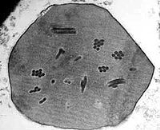
Baculovirus
Overview
Virus
A virus is a small infectious agent that can replicate only inside the living cells of organisms. Viruses infect all types of organisms, from animals and plants to bacteria and archaea...
es that can be divided to two genera: nucleopolyhedroviruses (NPV) and granuloviruses (GV). While GVs contain only one nucleocapsid
Capsid
A capsid is the protein shell of a virus. It consists of several oligomeric structural subunits made of protein called protomers. The observable 3-dimensional morphological subunits, which may or may not correspond to individual proteins, are called capsomeres. The capsid encloses the genetic...
per envelope
Viral envelope
Many viruses have viral envelopes covering their protein capsids. The envelopes typically are derived from portions of the host cell membranes , but include some viral glycoproteins. Functionally, viral envelopes are used to help viruses enter host cells...
, NPVs contain either single (SNPV) or multiple (MNPV) nucleocapsids per envelope. The enveloped virions are further occluded in granulin matrix in GVs and polyhedrin
Polyhedrin
Polyhedrins are proteins that form virus occlusion bodies, large structures that protect the virus from the outside environment for extended periods until they are ingested by insect larvae. They occur in various viruses including the single nucleocapsid nuclear polyhedrosis viruses and...
for NPVs. Moreover, GV have only single virion per granulin occlusion body while polyhedra can contain multiple embedded virions.
Baculoviruses have very species-specific tropisms among the invertebrate
Invertebrate
An invertebrate is an animal without a backbone. The group includes 97% of all animal species – all animals except those in the chordate subphylum Vertebrata .Invertebrates form a paraphyletic group...
s with over 600 host species having been described.
Unanswered Questions

